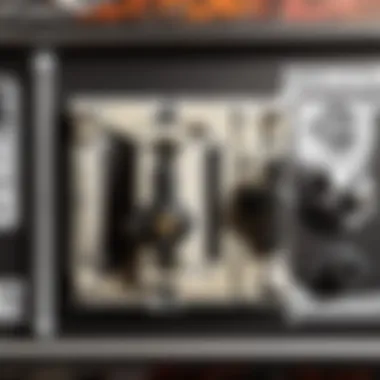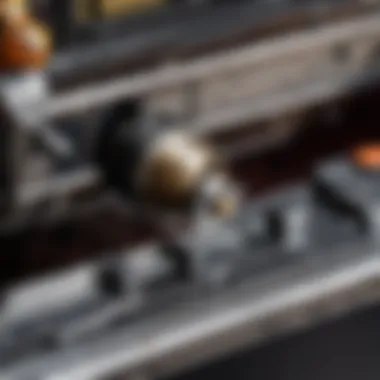Mastering TV Mounting Screws: A Comprehensive Guide for Success


Ultimate Guide to TV Mounting Screws
TV mounting screws play a crucial role in securely installing your TV. Understanding the types and sizes of these screws is essential for a successful mounting project. This guide provides a comprehensive overview of TV mounting screws, equipping you with the knowledge needed to tackle your TV installation with confidence.
Types of TV Mounting Screws
When it comes to TV mounting screws, there are various types available in the market. These include VESA screws, machine screws, wood screws, and drywall anchors. Each type serves a specific purpose based on the mounting surface and TV model.
VESA screws, for instance, are standardized screws used for mounting TVs on VESA-compliant mounts. Machine screws are ideal for attaching the TV bracket to the back of the television. Wood screws are suitable for mounting on wooden surfaces, offering a secure hold. Drywall anchors come in handy when mounting on hollow walls, providing the necessary support.
Understanding the differences between these types of screws is crucial to ensure a stable and secure TV installation.
Sizes of TV Mounting Screws
TV mounting screws are available in various sizes, typically measured in diameter and length. The size of the screws required for your TV mount depends on the VESA pattern of your television and the thickness of the mounting surface.
It's important to select the right size of screws to prevent any mishaps during the installation process. Using incorrect screw sizes can lead to instability and potential damage to your TV.
Before purchasing TV mounting screws, refer to the manufacturer's guidelines or consult a professional to determine the appropriate sizes for your specific TV model.
Installation Procedures
Now that you understand the types and sizes of TV mounting screws, let's delve into the installation procedures. Begin by identifying the VESA pattern of your TV, which corresponds to the spacing of the mounting holes on the back of the television.
Once you have determined the VESA pattern, select the appropriate type and size of screws accordingly. Use a screwdriver or drill to securely attach the TV bracket to the TV, ensuring that the screws are tightened snugly.
Next, locate the stud or use drywall anchors for mounting on the wall. Position the TV mount at the desired height and mark the drilling points. Proceed to drill pilot holes and attach the mount to the wall using the designated screws.
After mounting the TV, perform a stability check to ensure that it is securely fastened. Make any necessary adjustments to the tilt or position of the TV for optimal viewing experience.
By following these detailed installation procedures and utilizing the correct types and sizes of TV mounting screws, you can achieve a safe and professional-looking TV setup in your home.
Introduction to TV Mounting Screws
TV mounting screws play a crucial role in securely installing your television onto a wall mount. Understanding the various types and sizes of screws is essential to ensure a proper and safe mounting procedure. This section provides a detailed overview of TV mounting screws, from standard screws to metric screws and machine screws.
Types of TV Mounting Screws
Standard Screws
Standard screws are commonly used in TV mounting due to their versatility and availability. These screws have a traditional threading pattern that allows for a secure attachment between the TV mount and the wall. While standard screws may not offer specialized features, their widespread usage makes them a reliable choice for various mounting applications.
Metric Screws
Metric screws are measured using the metric system, offering precise sizing for different mounting needs. These screws provide a more standardized approach compared to imperial measurements, ensuring compatibility with a wide range of TV mounts. With metric screws, you can achieve a more accurate and secure TV installation.


Machine Screws
Machine screws feature a uniform diameter and thread pitch, making them ideal for securely fastening components together. These screws are commonly used in electronic devices and appliances due to their reliability and stability. When selecting machine screws for TV mounting, ensure they are compatible with your TV's mounting holes to avoid any installation issues.
Understanding Screw Sizes
Gauge vs. Diameter
The gauge of a screw refers to its thickness, while the diameter represents the width of the screw's thread. Understanding the difference between gauge and diameter is crucial for selecting the right screw size for your specific TV mounting requirements. By determining the optimal gauge and diameter, you can ensure a secure and stable attachment between the TV and the wall.
Length Measurement
The length of a screw is a critical factor in TV mounting, as it determines how securely the TV will be attached to the wall. Choosing the correct screw length is essential to prevent instability or potential accidents. By carefully measuring the length of the screws needed for your TV mount, you can maintain optimal safety and durability throughout the mounting process.
Common Head Types
Phillips Head
Phillips head screws feature a cross-shaped indentation on the head, enabling easy installation with a compatible screwdriver. These screws are common in household applications and offer efficient installation for a variety of mounting projects. The Phillips head design prevents slipping during installation, ensuring a smooth and secure mounting process.
Flat Head
Flat head screws have a flat-top surface that sits flush with the material being fastened. This design allows for a seamless finish once the screw is fully installed. Flat head screws are commonly used in applications where a smooth and level surface is desired, providing an aesthetically pleasing look for your TV mounting setup.
Hex Head
Hex head screws feature a hexagonal-shaped head that provides increased torque during installation. The six-sided design of hex head screws offers enhanced gripping power, making them ideal for applications that require a high level of fastening strength. When using hex head screws for TV mounting, you can benefit from their superior stability and resistance to stripping.
Selecting the Right Screws
When delving into the realm of TV mounting screws, the significance of selecting the correct screws cannot be overstated. The suitability of the screws chosen plays a pivotal role in the structural integrity and stability of the mounted TV. Not only do the right screws ensure a secure attachment between the TV and the mounting bracket, but they also contribute to the overall safety of the setup. Selecting the appropriate screws involves meticulous consideration of various factors to guarantee a successful TV mounting experience.
Factors to Consider
TV Weight and Size
In the process of choosing the right screws, one must first evaluate the weight and size of the TV that will be mounted. The weight and dimensions of the TV determine the load-bearing capacity required of the screws. It is crucial to select screws that can support the specific weight of the TV without compromising the integrity of the mounting. Utilizing screws that are inadequate for the TV's weight can lead to instability and potential safety hazards. Therefore, a thorough assessment of the TV's weight and size is essential to ensure the chosen screws can uphold the TV securely.
Wall Material
The composition of the wall where the TV mounting will take place is another critical consideration. Different wall materials, such as drywall, concrete, or wood, necessitate distinct types of screws for optimal mounting. The texture and density of the wall material impact the gripping power and stability of the screws. Choosing the appropriate screws that are compatible with the specific wall material is imperative for a robust and durable mounting. Failure to account for the wall material can result in inadequate fixation and potential damage to the wall structure.
VESA Pattern
When selecting TV mounting screws, considering the VESA (Video Electronics Standards Association) pattern is essential for a seamless installation. The VESA pattern denotes the arrangement of mounting holes on the back of the TV, standardized for various TV brands and models. Aligning the screws with the correct VESA pattern ensures proper alignment and attachment of the TV to the mounting bracket. Choosing screws that correspond to the VESA pattern of the TV guarantees a snug fit and enhances the overall stability of the mounted television.
Consulting the TV Manual


Manufacturer Recommendations
Consulting the TV manual for manufacturer recommendations on suitable screws is a prudent step in the mounting process. Manufacturers often provide specific guidelines regarding the type, size, and installation protocol of screws compatible with their TV models. Adhering to the manufacturer's recommendations ensures optimal compatibility and minimizes the risk of structural damage or instability. Following the prescribed screw specifications outlined in the TV manual is integral to achieving a secure and reliable TV mounting setup.
Precautionary Tips
In addition to manufacturer recommendations, incorporating precautionary tips outlined in the TV manual enhances the safety and efficacy of the mounting procedure. Precautionary tips may include instructions on ensuring proper ventilation behind the mounted TV, avoiding over-tightening of screws, and conducting regular maintenance checks. These tips serve to optimize the longevity and functionality of the mounting system while mitigating potential risks or malfunctions. Adhering to the precautionary guidelines stipulated in the TV manual is paramount for a successful and hassle-free TV mounting experience.
Installation Process
In this section, we will explore the crucial steps involved in the installation process of mounting your TV. Understanding the installation process is vital as it ensures the safe and secure attachment of your TV to the wall, preventing any accidents or damage. This section will focus on pre-installation steps, securing the mounting bracket, and mounting the TV, providing a detailed guide for a successful installation.
Pre-Installation Steps
Before starting the installation process, it is essential to gather the necessary tools required for the job. The tools you will need include a stud finder, measuring tape, level, drill, screws, and screwdriver. These tools play a significant role in ensuring the accuracy and stability of the TV mount. Measuring and marking the wall correctly is another crucial pre-installation step. By using a measuring tape and level, you can mark the exact position and height where the TV mount should be placed. This meticulous measurement process helps in avoiding any misalignment or errors during the installation.
Gathering Tools
The process of gathering tools is essential as it sets the foundation for a successful TV mounting project. Each tool serves a specific purpose, ensuring that the mounting process is carried out efficiently and accurately. For example, a stud finder helps locate the studs in the wall, providing a secure anchor point for the TV mount. Additionally, using a level ensures that the mount is placed straight, avoiding any crooked positioning that could affect the TV's stability.
Measuring and Marking
Measuring and marking the wall accurately is critical for a seamless installation process. By using a measuring tape, you can determine the precise height and position for the TV mount. Marking the spots where the screws will go with a pencil ensures that the mount is aligned correctly. This attention to detail at the pre-installation stage contributes to a hassle-free mounting experience.
Securing the Mounting Bracket
Securing the mounting bracket involves drilling pilot holes and attaching the bracket to the wall. Drilling pilot holes is a necessary step to prevent the wall from splitting or cracking when inserting the screws. It also ensures a firm grip for the screws, enhancing the overall stability of the TV mount. Attaching the bracket securely to the wall is crucial, as it will bear the weight of the TV.
Drilling Pilot Holes
Drilling pilot holes is a fundamental step in the installation process that should not be overlooked. These small holes guide the screws into the wall, preventing any damage and providing a secure anchor for the bracket. The key characteristic of drilling pilot holes is precision; the holes need to be the right depth and diameter to accommodate the screws effectively. This methodical approach minimizes the risk of errors and ensures a sturdy mount.
Attaching the Bracket
Attaching the bracket is the next step after drilling pilot holes. It involves securing the bracket to the wall using screws, ensuring it is level and tightly fastened. The key characteristic of attaching the bracket is stability; the bracket should be firmly fixed to support the weight of the TV without any wobbling. This secure attachment is essential for a safe and long-lasting TV mounting solution.
Mounting the TV
Aligning the screws and tightening them ensures that the TV is securely mounted on the wall. This step is crucial for maintaining the TV's stability and preventing any accidents. Aligning the screws accurately and adjusting them as needed guarantees that the TV is level and firmly in place.
Aligning the Screws
Aligning the screws correctly is essential to ensure that the TV mount is level and balanced. By aligning the screws accurately with the pre-marked spots on the wall, you can guarantee that the TV will hang straight. The key characteristic of aligning the screws is precision; even minor misalignments can impact the TV's stability and appearance. This meticulous approach results in a flawless mounting finish.
Tightening and Adjusting


Tightening the screws securely is the final step in mounting the TV. Each screw should be tightened appropriately to provide solid support for the TV. Adjusting the TV position slightly after tightening the screws allows for final adjustments to ensure the TV is perfectly level. The key characteristic of tightening and adjusting is balance; a well-balanced TV mount prevents tilting or shifting, enhancing both safety and visual appeal. By following these steps, you can achieve a professional and secure TV installation.
Safety Tips and Considerations
When embarking on a TV mounting project, safety should be the primary focus to ensure a secure installation and prevent any accidents. Anchoring the TV mount to studs is crucial for stability and weight support, making it imperative to employ the right tools and techniques. Proper cable management is vital not only for aesthetics but also for maintaining the integrity of the setup. By following these safety tips and considerations meticulously, you can safeguard your investment and enhance the durability of your TV mounting structure.
Anchoring to Studs
Stud Finder Usage
Utilizing a stud finder is instrumental in locating the studs behind the wall to anchor the TV mount securely. The key advantage of using a stud finder is its precision in identifying the exact position of the studs, enabling you to drill holes accurately without causing unnecessary damage to the wall. One unique feature of stud finder usage is its ability to detect not only studs but also electrical wires or pipes hidden within the wall, preventing potential hazards during installation. While stud finders simplify the anchoring process, it's essential to calibrate them correctly and follow the instructions meticulously for optimal results.
Weight Distribution
Ensuring proper weight distribution when anchoring the TV mount to studs is vital for maintaining balance and stability. By evenly distributing the weight across multiple studs, you can prevent stress concentration on a single point and minimize the risk of wall damage. The key characteristic of weight distribution is its ability to disperse the load efficiently, reducing the strain on individual mounting points. This method not only enhances the structural integrity of the installation but also prolongs the lifespan of the wall by minimizing wear and tear. While weight distribution contributes to overall stability, it's essential to use appropriate hardware and follow manufacturer guidelines for optimal support.
Securing Cables
Cable Management
Effective cable management plays a vital role in maintaining a tidy and organized setup while ensuring the safety of your TV mounting system. Proper cable management involves routing cables neatly along the wall or within cable concealers to prevent tangling and protect them from damage. The key characteristic of cable management is its ability to streamline the visual appeal of your entertainment area by concealing unsightly wires and creating a seamless look. By incorporating cable management solutions, you can enhance the overall aesthetics of your space while minimizing tripping hazards and potential signal interference.
Organizing Connections
Organizing connections involves grouping and labeling cables to facilitate easy identification and troubleshooting when necessary. Proper organization of connections not only simplifies maintenance tasks but also reduces the risk of incorrect cable configurations, which can lead to connectivity issues. The key feature of organizing connections is its systematic approach to categorizing cables based on their function or source, allowing for quick and efficient management. By implementing clear labeling and segregation techniques, you can ensure that each connection is secure and easily accessible, promoting a hassle-free user experience and minimizing downtime due to technical issues.
Final Checks and Adjustments
In the exhaustive voyage through the realm of TV mounting screws, the phase of Final Checks and Adjustments emerges as the ultimate sentinel, ensuring the zenith of precision and stability in your installation endeavor. As the finishing touch in this intricate procedure, Final Checks and Adjustments play a pivotal role in validating the structural integrity and alignment of your mounted TV. This section encapsulates the crucial last steps that consolidate your efforts into a flawless manifestation of expertise and meticulous execution.
Leveling the TV
At the crux of finalizing your TV mounting project lies the essential task of Leveling the TV, a quintessential element in achieving a visually harmonious and functionally superior outcome. Within this section, the meticulous process of Leveling the TV aims to eradicate any slants or discrepancies that might compromise the viewing experience or the structural stability of the installation.
Using a Level
Implementing a Level during the TV mounting process aligns the display perfectly parallel to the ground, ensuring an optimal viewing angle and minimizing any visual distortions. The characteristic precision of Using a Level lies in its ability to detect even the minutest deviations from the desired orientation, guaranteeing a symmetrical and professional appearance for your mounted TV. The popularity of Using a Level in this context stems from its foolproof method of achieving accuracy without relying on subjective estimations.
Fine-Tuning Alignment
The facet of Fine-Tuning Alignment embodies the meticulous adjustment phase that refines the positioning of the TV to absolute perfection. By delicately maneuvering the TV along the mounting bracket, Fine-Tuning Alignment complements the leveling process by fine-tuning the angles and ensuring uniform spacing between the screen and the wall. The advantageous aspect of Fine-Tuning Alignment lies in its capacity to rectify minor misalignments with precision, culminating in a polished and seamless visual display.
Testing Stability
Moving beyond the realm of aesthetics, Testing Stability delves into the functional aspects of the installation, evaluating the robustness of the mounting system under potential stressors. Within this segment, the critical components of Swivel and Tilt Functions and Ensuring Firm Placement assume center stage as the guardians of stability and security for your mounted TV.
Swivel and Tilt Functions
Swivel and Tilt Functions introduce a dynamic dimension to your TV mounting setup, permitting adjustable viewing angles and enhancing the versatility of your entertainment system. The prominent characteristic of Swivel and Tilt Functions lies in their ability to cater to individual viewing preferences, optimizing comfort and immersion for diverse audiences. Embracing Swivel and Tilt Functions in your installation broadens the horizons of interactive visual experiences.
Ensuring Firm Placement
Ensuring Firm Placement instills confidence in the structural integrity and safety of your mounted TV, safeguarding against unforeseen incidents and preserving the longevity of your setup. The inherent strength of Ensuring Firm Placement lies in its steadfast approach to stabilizing the TV on the mount, minimizing the risk of accidental displacement or damage. By prioritizing Firm Placement, you establish a secure foundation for prolonged enjoyment of your mounted TV, free from worrisome instabilities.



